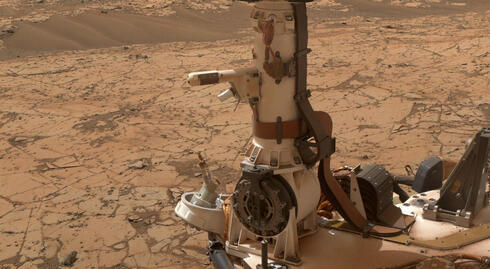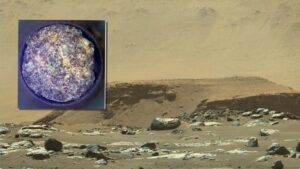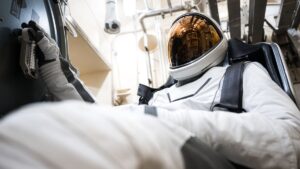Over 50 startups have signed up for the EXPAND program, an accelerator led by Israeli company Creation-Space and innovation community Tech7, along with additional partners supported by the Israel Space Agency. Among these applicants, five companies will be selected to receive comprehensive business and professional guidance tailored to the space sector, with an emphasis on developing projects to be implemented on the Moon and possibly other planets. This support is intended to make it easier for selected companies to submit proposals for NASA’s Artemis program, which plans to return humans to the moon in the near future.
1 See the gallery

“The majority of submissions focus on construction-related innovations, ranging from excavation technologies or 3D printing to energy production, food production or medicine,” Creation-Space CEO Roy Naor told the website of Davidson Institute. “We are in the process of conducting interviews with representatives of various companies and the winners will be announced during the official accelerator launch event at Mitzpe Ramon in about a week”
The five selected companies will participate in an intensive mentoring program that includes guidance on developing a space-specific business plan, raising funds, dealing with authorities and navigating regulatory frameworks, and more. In September, they will present their products at an event attended by investors and representatives of the Israeli space community, where the winning company will be announced. The winning company will receive a grant of 100,000 shekels for further product development. All five companies will continue to receive professional mentoring from the accelerator team for approximately one year, along with the launch of the second accelerator cycle for additional companies.
“Israel has enormous potential to make a significant contribution to the space sector and integrate into the Artemis program and other space initiatives,” Naor said. “The goal of the program is to harness this potential and harness the capabilities of Israeli businesses. However, we are not only focused on applications exclusively for the space sector; we also aim to identify companies whose products have significant market potential here on Earth and can help address our challenges here, such as climate change.”
An international team of scientists using the James Webb Space Telescope has identified a collision of galaxies with black holes at their centers that occurred when the universe was young. This discovery suggests that such giant black holes formed faster than previously thought. Researchers have identified the processes of galaxy mergers in a system known as ZS7, located more than 13 billion light-years away, appearing to us as it did when the universe was only 740 million years old.
Black holes themselves cannot be seen through a telescope because they absorb the light that reaches them. However, it is possible to identify their accretion disk – the area where matter orbits them on its way to absorption – thanks to the emission of radiation with wavelengths characteristic of gases and other materials affected by the black hole’s immense gravity. “We found evidence of very dense, fast-moving gas in the vicinity of the black hole, as well as hot and highly ionized gas illuminated by the energetic radiation normally produced by black holes in their accretion episodes,” explained research team leader Hanna Ubler of University of Cambridge, United Kingdom. “Thanks to the unprecedented sharpness of its imaging capabilities, Webb also allowed our team to spatially separate the two black holes.”
Researchers estimate that one of the black holes has a mass 50 million times that of our Sun. Estimating the mass of the other black hole is more difficult because it is hidden in a cloud of gas, but researchers believe it is of a similar size.
At the centers of most known large galaxies is a supermassive black hole, including the Milky Way, whose central black hole has a mass four million times that of our Sun. One of the open questions in astrophysics is how black holes reached such enormous sizes and how they affected the evolution of their galaxies. “Our findings suggest that mergers are an important pathway through which black holes can grow rapidly, even in the cosmic dawn,” Uebler added. “Together with other Webb discoveries of active, massive black holes in the distant Universe, our results also show that massive black holes have shaped the evolution of galaxies from the very beginning.”
SpaceX recently unveiled its new line of spacesuits designed for extravehicular activities known as “spacewalks” — where astronauts step outside the spacecraft, relying solely on their suits for protection against the harsh conditions of space. These suits are to be tested for the first time during the Polaris 1 mission, also called “Dawn” (or Polaris Dawn), the first space mission to include a spacewalk by private astronauts.
The Polaris program is expected to include three missions, with the first planned for this coming summer, although final details have yet to be revealed. Led by billionaire Jared Isaacman, who previously funded and led the first private Earth-orbiting space mission, Inspiration 4 in 2021, the inaugural Polaris mission will see Isaacman and three other private astronauts orbit Earth aboard a spacecraft Dragon for five days. During this time, they will conduct various experiments, with two astronauts taking a spacewalk to evaluate the functionality of the new suits. Because Dragon is a small spacecraft without an “airlock,” all astronauts will wear spacesuits, meaning that even those who don’t go outside will be exposed to the space environment. This mission will mark not only the first spacewalk by private astronauts, but also the first time that four astronauts will stand up simultaneously in space conditions.
SpaceX’s newest space suit represents a significant improvement over the current attire worn by astronauts aboard the Dragon spacecraft. Although existing suits are designed to protect astronauts in the event of spacecraft damage or external damage, they are not optimized for sustained activities outside the spacecraft. “Developed with mobility in mind, SpaceX teams incorporated new materials, manufacturing processes and new joint designs to provide astronauts with greater flexibility in pressurized scenarios while maintaining comfort for non-pressurized scenarios,” a press release said of SpaceX. According to the release, the suits include 3D-printed helmets, helmet-mounted cameras, improved face shields and internal displays that present vital data such as pressure, temperature and humidity inside the suit. They are also equipped with additional safety features, including valves and seals, designed to maintain suit pressure integrity during operation and protect the astronaut.
SpaceX emphasizes that the current development marks a significant step toward mass production of spacesuits tailored for different body sizes and types. These suits, which will allow many different people to go into space, represent another step in SpaceX’s broader plan to contribute to lunar colonization efforts and to start the creation of human settlements on Mars.
Currently, the only initiative actively working to land humans on the moon is NASA’s Artemis program. Despite the delays and setbacks, the Artemis program continues to make steady progress, and even if NASA doesn’t reach its planned goal of a manned landing by the end of 2026, we hope that humans will again set foot on the lunar surface by the end of the decade. The agency continues its preparations, and this week two astronauts conducted a training session simulating activity on the lunar surface to test equipment and operational procedures in preparation for the Artemis 3 mission.
Astronauts Kate Rubins and Andre Douglas, wearing simulation suits, tested a wide range of equipment and technology in a volcanic valley in northern Arizona. The tests included a variety of equipment and technology, such as new devices for collecting soil samples, navigation and orientation in the field using virtual reality displays in their helmets, and a system for calibrating signals from the lunar lander.
“Field tests play a critical role in helping us test all the systems, hardware and technology we will need to conduct successful lunar operations during the Artemis missions,” said NASA Johnson Space Center Director of Field Tests Barbara Janoiko. “Our engineering and science teams work seamlessly together to ensure we are prepared every step of the way when astronauts step on the moon again.”
A team of researchers from the United States has discovered three of the oldest known stars located on the outskirts of our own Milky Way galaxy. Led by Anna Froebel of the Massachusetts Institute of Technology (MIT), the researchers first came across these celestial relics during a space archeology course taught by Froebel herself. They estimate that these stars are between 12 and 13 billion years old, and that they formed when the universe was very young and composed mostly of hydrogen and helium. Examination of their light spectrum shows that they are extremely poor in other elements, such as iron, barium and strontium, which are usually found in stars that formed later.
The stars were discovered as students in the course analyzed observations made by Froebel a decade earlier using the Magellan telescope in Chile. They found the stars in an area known as a “halo” around the Milky Way. The researchers calculated their orbits based on observations from the Gaia space telescope, which maps the Milky Way with high precision. They were surprised to find that these stars were moving in the opposite direction to most of the other stars orbiting the center of the galaxy. Based on this discovery, researchers believe that these stars were once part of dwarf galaxies that were gradually absorbed by the Milky Way, remaining as orphans at its edges, about 30,000 light years away, continuing in their ancient orbits billions years.
Froebel and her colleagues began scanning the scientific literature for reports of similar stars drifting along the edges of the galaxy exhibiting anti-directional motions, eventually finding records of 65 such stars that are also poor in strontium and barium. They believe there are many more, and now they intend to hunt them down. “These oldest stars should definitely be there, given what we know about galaxy formation. They are part of our cosmic family tree. And now we have a new way to find them,” Froebel said. “…that was the piece of the puzzle that we needed and that I didn’t quite expect when we started.”



